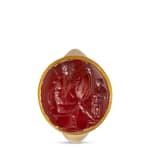Roman
Further images
Provenance
Sotheby’s, New York, 8 June 1994, lot 234
Private collection, Philadelphia, USA, acquired from the above
Literature
The trophaion (or tropaeum in Latin) was a trophy, a monument erected to commemorate a victory in battle. It was in the form of the armour of a defeated enemy and in ancient Greece it was set up on the battlefield, with the armour hung on a tree. It would be a votive offering to a deity in thanks for the victory. By the time of Ancient Rome, trophies were displayed prominently in public areas of the city of Rome for all to see. During the Republic, this was with the purpose of political self-aggrandisement for the victorious general, enhancing his public profile as he advanced the cursus honorum. In Imperial Rome, such imagery was employed on media as diverse as coins, gems and sculptural reliefs, for the glory of the emperor and to convey the might of Rome.





